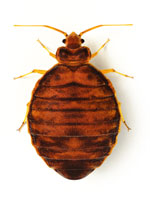Bed Bugs
Please Meet Our Guest Author
Jody Gangloff-Kaufman, Ph.D. is an entomologist and a Senior Extension Associate for the New York State Integrated Pest Management (IPM) Program at Cornell University and a pest management industry consultant. She earned her Ph.D. at Cornell University and went on to specialize in IPM for urban and public health pests such as wasps, ticks and especially bed bugs. Located on Long Island, she has worked closely with government and non-profit agencies in the City of New York to advance the awareness about bed bugs and develop protocols, guidelines and recommendations for their treatment. Dr. Gangloff-Kaufmann served on the New York City Bed Bug Advisory Board and currently serves on the Nassau County Bed Bug Task Force.
Please note that her contribution of this informative article does not mean that Dr. Gangloff-Kaufman endorses any particular products sold by National Allergy or any other company.
Why Bed Bugs Continue To Be On The Rise
No doubt, if you are in touch with any form of media, you have heard that bed bugs are on the rise. This is happening all over the United States and throughout the world. Truthfully, bed bugs never went away, but the numbers of infestations in the US, Canada, Britain and Australia, for example, have risen dramatically over the past ten years. The question most people ask is "Why?".
Bed bugs were a common household pest before World War II. One report claims that as many as 30% of homes in Britain had bed bugs. With the development of chemical insecticides after the war, people had new tools to combat all sorts of pests, including bed bugs. Since that time many pesticide tools have been removed from the market. Bed bugs have grown tolerant of what products remain. People lost familiarity with bed bugs and a whole generation or two had never seen one. People travel considerably more these days. Additionally, more people have more stuff. More stuff makes bed bug control difficult. The bottom line is nobody can say for sure why bed bugs have reappeared. But they have and now we must face it, for there appears to be no "silver bullet" solution in the near future.
Bed bugs are insects with six legs and no wings. The adults are the size and color of apple seeds and the younger ones are similar to small sesame seeds until they fill with blood. All stages, except the egg, must feed on blood in order to grow. The mouthparts are similar to the stylet of a mosquito. The good news is that bed bugs have never been shown to transmit disease. The bad news is that bed bugs may be "the disease" as they cause itchy welts that can scar. For some people infestations lead to mental health issues. People suffering with chronic bed bug infestations often become isolated from family and friends, who fear getting bed bugs themselves. The process of bed bug elimination can be overwhelming and costly, leading to fatigue, anxiety and depression. If untreated, bed bug numbers will only grow and spread. For these significant reasons bed bugs must be taken seriously starting with early detection and thorough treatment.
Signs Of Bed Bugs In The Home
Ten years ago bed bugs began to appear in the homes of people who travelled frequently. They are excellent hitchhikers. Today bed bugs are transferred among people or households in many ways. They may hitch a ride on a bag, coat, or even used furniture. Bed bugs will also actively move if they have no access to a person. Only a mated female bed bug can establish a new infestation, males and youngsters are dead ends. Once established, the first thing a person might notice is the bites. Bed bug bites vary widely from person to person. Some people do not react to bites while others have serious allergic reactions, including large red welts and sometimes blisters. Be aware of skin irritations but keep in mind that bites alone cannot be used to confirm a bed bug problem. What looks like bites can be the result of many different things, including environmental or food allergies. Another early sign of bed bugs is the dark spotty stains they leave behind. When bed bugs digest a blood meal, the excrement is either tan (plasma) or black (blood cells). It comes out as a liquid and may soak into fabric or dry on a hard surface. Spots are tiny - never bigger than the bug that made them. Bed bugs hide in crevices no wider than a credit card is thick. Stains are often found on the outside of the hiding spot. If bites or stains are discovered, inspect immediately or hire a pest management professional!
The inspection process is complex, yet logical. Begin inspection where people sleep. On a bed, remove linens carefully while inspecting them. Check every fold and cranny on the mattress, box spring and bed frame. Look between the mattress and box spring and where the box spring sits on the frame. Consider couches and chairs where people may nap. Look in every fold, under every cushion and underneath the furniture. At low levels, bed bugs can be challenging to find. If nothing can be found there are two options: wait and see, or hire a professional.
Getting Rid Of Bed Bugs
If you do find that your home has bed bugs, be prepared to hire a pest management professional and to follow instructions given to you. However, not every protocol for bed bug control is well thought out. For example, discarding furniture and belongings is no longer a standard practice. Items can be treated with heat (over 125 degrees F) or simple isolation (6-8 months in an airtight bag or container). Mattresses and box springs should be encased unless these items are badly infested. Bed bug-proof encasements are very helpful and do several things. First, if there is a low-level infestation and the bed frame is thoroughly treated (bed bug free), the mattress and box spring encasements prevent the emergence of any bed bugs hiding within. They entomb the bugs where they will eventually die. Second, adding an encasement will protect new bedding from becoming directly infested - bed bugs can only be on the outside surface. And third, bed bug-proof encasements are designed to have no flaps or seams that allow bed bugs to hide out of sight. They make bed bugs easy to find and kill.
In addition to isolating belongings, be prepared to clean and reduce clutter. Nothing encourages bed bugs and other pests better than household clutter. If your home is cluttered consider renting a storage space and moving items (isolated and protected in bags and airtight bins!) into storage for a period of at least 6 months. This is a good option for books, extra furniture and collections.
The pest management professional that you hire should be experienced with bed bug treatments (check references!). They should use more than one technique (pesticides, heat, steam, freezing, traps) in a combination that will work for your home. They should also be willing to discuss with you the course of action and outline benchmarks for success (60 days with no bites, for example).
Bed Bug Prevention
Preventing the spread of bed bugs is the ultimate goal. Every person who ventures out into the world should take precautions. Understand the bed bug; know what they look like at all stages of life. Learn where the higher risk areas are for you - a senior center, movie theater, taxi, or school for example. At the very least, if you have visited a higher risk area, check the seams and pockets of clothing, coat, shoes and any bags or items brought along. Remember that only an adult female can start an infestation alone and they are easily seen. If you know you have been exposed to bed bugs, isolate and inspect or heat treat everything you're wearing and have carried along with you. Practice "infection control" to prevent transferring bed bugs into your own home. There is a lot to know about bed bugs and their management for various settings. Visit the New York State IPM Program website to learn more.



